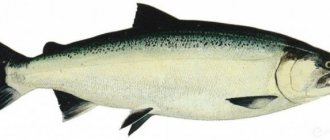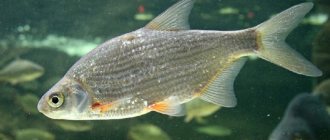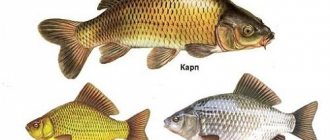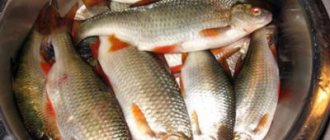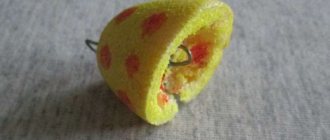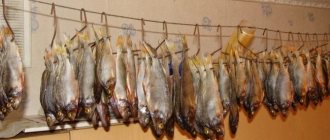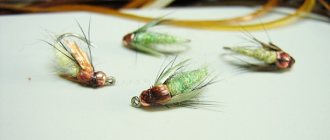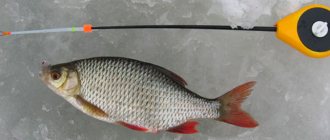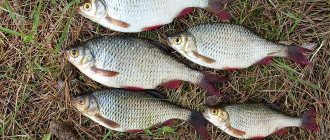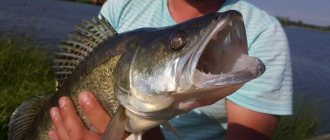What is the difference between roach and rudd
3 minutes Author: Konstantin Pavlov 0
Roach and rudd are common inhabitants of our reservoirs, fishing for which is popular among domestic fishing enthusiasts. Experienced fishermen can tell them apart without any difficulty, but beginners often have questions and cannot always determine who got hooked.
In this material we will look at how roach differs from rudd, what features each type of fish has, and what characteristic places they live. For novice fishermen, this information will help them better navigate the reservoir and accurately recognize the caught representative of the ichthyofauna.
Coloring and scales
The external differences of these fish are quite noticeable to a trained eye: while the roach has light red eyes, the rudd has rather yellow-orange eyes. The fins of the roach are brownish-red, while those of the rudd are bright red, and sometimes even almost burgundy-crimson, which justifies the name of the fish.
Differences in scale color are also noticeable. The roach has silver-tin-colored scales, and gray-silver scales on the back. The scales of the rudd shine with a bright brass-silver sheen, almost without changing their color on the back of the fish.
External differences
It is not difficult to distinguish both of these types of underwater inhabitants. Outwardly, these fish have similar characteristics, but there are even more differences in them. The first photo below shows a roach, the second one shows a rudd.
The characteristic differences between rudd and roach are:
- Body shape. The rudd has a rounded body, somewhat reminiscent of a crucian carp. The roach is more elongated and driven.
- The size of the rudd's head in relation to the body is larger than that of the roach. The mouth is directed upward, whereas in the roach it is straight and smaller.
- The fish's eyes are approximately the same size. However, in roach they have a reddish or orange tint, in rudd it is white or light yellow.
- The dorsal fin of the roach is located on the same level as the paired ventral fins. In the rudd it is shifted closer to the anal. In the first, the number of rays in the dorsal fin is from 10 to 12, in the second - 8–9.
- The rudd is easily recognized by its bright red fins. Roaches have orange, light red, yellow or even gray fins, depending on the region and habitat conditions.
- How to distinguish fish by color? The scales of the roach have a silvery tint, with a slightly bluish tint on the back. The rudd is golden, dark green or olive on top.
Another difference between roach and rudd is the presence of mucus on the body of the caught fish. The roach is covered with a rich layer of slippery mass, so holding it in your hand is quite problematic. Rudd has rough scales and is less slimy.
These representatives of the ichthyofauna have approximately the same size. Most catches include specimens weighing from 50 to 300 grams. However, they can grow up to a kilogram, therefore, by this indicator it will not be possible to distinguish between roach and rudd.
Roach everything you wanted to know but were afraid to ask
Hello everyone, I am glad to see you on our blog about fishing and spearfishing. Roach, what do we know about this small fish. Where does it live and what does it feed on, where does it go to spawn. And how big does it grow? I propose to look into these issues right now.
This small fish has quite a few nicknames and names in every corner of our large homeland, it has its own name in the south everyone knows it as a ram, in the northern latitudes it is known as a soroga or soroga. In the vastness of the Urals it is better known as chebak, chebak, but according to its passport it is still a roach.
Its dimensions range from 10-20 cm. Well, a little more than the palm of an adult. The fish is not large in size and weighs not much, 20-30 grams. But there was a case of catching a roach weighing 2.5 kg and over half a meter long, that’s the catch, isn’t it?
Habitats
Roach and rudd can also be distinguished by their habitats. Rudd mainly loves water areas without a current or areas where the water flow slows down and there is no need to spend effort fighting it. For this fish, the presence of algae is important. You will never meet her on a clean day. You should look for this underwater inhabitant in the following locations:
- Oxbow lakes, backwaters, closed branches from the main channel.
- Sleeves and ducts.
- Coastal strip of algae in locations with slow currents.
- Extensive shallow water areas, abundantly covered with aquatic vegetation.
The rudd inhabits not only rivers and reservoirs. It is successfully caught in many lakes, swamps, toad beds, ponds and quarries.
Roach can also be found in the listed places. Moreover, during fishing, these fish can be found interspersed. This applies to small-sized individuals. Medium and large specimens prefer the following characteristic locations:
- Pits and dumps with a muddy, sandy or pebble bottom.
- Extended grooves with aquatic vegetation or single shelters in the form of flooded logs or snags.
- Hydraulic structures.
- Wide reaches with uneven bottom relief.
These representatives are distinguished by the fact that roach can live calmly in weak or medium currents. In addition, this fish is characterized by seasonal migrations - in the spring before spawning and in the fall before wintering.
The diet of roaches consists mainly of bottom invertebrates and plant foods. Rudd, in addition, willingly eats insects falling into the water, and large individuals love to feast on small fish, which is confirmed by many experienced spinning anglers who successfully catch this underwater inhabitant using ultralight.
Body and lips
But the main difference between these fish is the shape of the body and lips. For example, roach is more squat, narrow and elongated. The rudd is wider, and the crescent of its lower body seems to look up.
The structure of the rudd's lips indicates its predilection for feeding on the surface of the reservoir: the lower lip of this fish is somewhat enlarged and pushed forward - this makes it more convenient to grab insects falling into the water and collect various aquatic invertebrates - snails, leeches and worms living on the lower surface of water lily leaves. Rudd loves this aquatic plant very much, and almost always this fish can be found near it. The lips of the rudd also differ in color: in the rudd they are yellowish.
Roaches have gray-silver lips. The cut of the mouth is straight with a barely noticeable slope towards the bottom - this makes it easier for the fish to get food from the bottom of the reservoir.
Ram and roach: the difference in fishing
Roach that spawns in fresh waters and feeds in desalinated waters is called semi-anadromous roach. This fish caught in the Caspian Sea basin will be called roach. Fishing for semi-anadromous roach in the Black and Azov Seas is already a ramming operation.
Such species of fish grow and develop faster than ordinary freshwater (live) roach, which does not go beyond the traditional spawning site. It is worth saying that roach, ram and roach gather in schools of fish before spawning, which makes fishing easier.
Roach spawning
For the most part, roach is still a freshwater resident, but there are two renegades from the main family: Taran, a resident of the Azov Sea, and Vobla, a resident of the Caspian Sea.
Although they live in the sea, they go to rivers to spawn. After spawning, they return back to their native land. Both fish are readily caught on an industrial scale, since these species of fish are considered commercial. Not only sea roach go to rivers to spawn, but almost all freshwater roach, also, if they have the opportunity to get into the river to spawn, go upstream to search for the most favorable places for laying eggs.
At the beginning of spring, a huge number of our brother waits for the end of spawning to catch roach on the way back to the sea. It is especially wonderful to watch the spawning of this red-eyed fish; usually this rather friendly company begins to foam the surface of the water in an attempt to shed eggs.
Cooking salted fish
Roach and ram differ not only in habitat, but also in size, that is, in morphological characteristics. Roach, for example, is larger than ram and even more so roach. Despite the external differences, these types of fish are prepared according to the same recipes.
Traditionally, this fish is salted, dried and dried, while ram gave the name to the entire assortment of small-sized salted dried fish - ram. Consequently, this pseudo name can hide a ram, a roach, and the same roach.
It is better to salt this fish in a dry way, that is, rub it with salt.
Small fish are only cleaned of scales (and even then not always), half-kilogram carcasses are better cleaned of entrails. Place the grated fish carcasses in rows in a wooden container and sprinkle thoroughly with table salt.
The fish will be salted in a refrigerated room for at least two weeks. Larger carcasses may require more for salting. At room temperature, pickling time is a week.
Where does the rudd live?
This fish does not live in areas where there is a strong current. The habitats of these fish are different. They are found in river bays and oxbows, flowing ponds, both small and large lakes and reservoirs. Selects the quietest areas where reeds, grasses, water lilies and other vegetation grow.
In addition to food, there is always shadow there, which serves as a good refuge from predatory fish. In addition, there is some pattern. Closer to the coast, small fish live in shoals among algae and driftwood in polluted areas. Mature fish, although they come to the shores to feed, spend most of their time in the wild, picking up watery, overgrown heights far from the shore.
The main habitat of rudd is bays and oxbow lakes, in addition, flowing ponds and reservoirs where many different plants grow. Here she can often be found in company with bream, and. She leads an almost sedentary lifestyle, staying in one area of her choice.
Photo 2. On a small river.
Dried fish
Before salting the fish, it is allowed to dry for several hours. Then they are treated with salt, as with dry salting, strung on a fishing line through the eye sockets (small fish can be collected in bunches of several pieces) and soaked in a saline solution for two days.
By the way, if you dry fish in the summer, then the salting time in the solution is no more than a day.
Subsequently, the ligaments are removed and washed with water. Hang the fish in an open, well-ventilated place; you can cover it with gauze to protect it from insects and dirt.
Dried ram will be ready in 2 weeks. Please note that in summer you need to monitor the fish more closely, as a product exposed to the sun may become bitter.
Lifestyle
These fish also differ in behavior. Rudd is more inclined to forage for food in the upper layers of water. The roach prefers to stay near the bottom, where it most often finds food. Although under certain circumstances, namely: mass flight of insects, movement of duckweed after heavy rains, it can even reach the surface for some time.
Another difference between these fish is that the rudd almost always avoids the current, preferring the quiet water of bays of lakes and rivers or coastal waters near algae stretching for kilometers along the banks of large rivers.
Roach loves places with medium and quiet currents, but not on the rapids itself, but where the river flow is calmer. This fish can be found especially often in areas where water flows wash away the clayey shore. The second favorite place for roaches is the border between coastal algae and clean water with a gentle current. Having fed it, you can catch it here all the time - the fish remembers the “feeding” areas and comes out to them when it has developed an appetite.
Tackle for rudd
The fish feeds at mid-water, which limits the number of equipment suitable for fishing. The most versatile is a float rod with a blank of 4-6 meters, which allows you to accurately cast the bait into a “window” among the vegetation. It is important to take into account the high probability of snagging, so a fishing line with a thickness of 0.15-0.2 mm with a tensile test of 2-3 kg is used.
If it is necessary to give additional buoyancy to a hook with a nozzle, a foam ball is placed on the fore-end. For catching rudd at a considerable distance from the shore (20-30 m), a long fast action Bolognese rod equipped with rings and a small spinning reel is well suited. If fishing involves fishing in open water at the border with vegetation, it is effective to use a sbirulino float (bombard) or a light spinning rod.
It is necessary to take into account the excellent sense of smell of the rudd, which is able to smell food at a considerable distance. If you choose the right bait, you can not only lure and hold a lot of fish, but force it to leave the overgrown area into an open place. For this purpose, dusty and strongly flavored, but not satisfying mixtures are used. Excellent results are demonstrated by bait for rudd, which includes:
- boiled corn (1 kg);
- vanilla (3-4 bags);
- honey (5 tablespoons);
- semolina or ground crackers (3 cups);
- steamed millet (0.3 kg);
- anise oil (10-15 drops).
Winter rudd is an inactive fish, which is characterized by a slowdown in life processes in a cold environment (anabiosis). But in shallow water areas covered with thickets of reeds or reeds, successful fishing is possible using nodding tackle with dark jigs (size 3-4 mm). Burdock fly larva, bloodworms or maggots are used as bait.
The best time to catch rudd from the ice is the first half of the day. The intensity of the bite is also affected by temperature - in severe frost the fish completely stops feeding, and vice versa - it actively looks for food on sunny days with a thaw and responds well to food turbidity. To do this, a little flour, porridge, and crackers are regularly thrown into the hole.
Use in cooking
Roach is not as popular in cooking as other types of fish. Most often at home it is salted, dried or smoked. Some people like to eat this fish fried. I use not only fish meat for food, but also caviar. Vobla can also be subjected to other heat treatment: a very popular dish is stewed roach in milk. It can also be boiled and used for preparing first courses.
You can prepare roach in many different ways. Most often it is salted by soaking it in brine or brine. We will tell you how to do this a little later in our article.
You can also soak the fish if it turns out too dry. The situation can be saved if you soften the fish using our recommendations. To do this, you will need clean cloth towels and plain water. Moisten the cloth so that it is damp but not wet, and wrap the dried roach in it, then put the product in the refrigerator for twenty-four hours. After this, the roach should become much softer, and if this does not happen, repeat the procedure, leaving the fish in the towel for another twelve hours, after moistening the fabric.
It is also necessary to clean the roach correctly. To do this, follow our recommendations:
- To begin, take the fish in your hands and knead it thoroughly, bending it in different directions so that the scales and skin separate from the meat and bones.
- Then grab the anal fin with one hand and pull it towards the fish's head to tear off the abdomen along with the pelvic fins.
- Cut off the head of the roach using a sharp knife.
- Also clean the insides of the roach with a knife. If there is roe in the fish, remove and clean it.
- Now you need to remove the skin and scales. This will be very easy to do if you have previously kneaded the fish. Simply pry the edge of the skin at the base of the head and pull it towards you, thus cleaning the entire carcass of the roach.
- After this, the dried or dried fish will be ready to eat. You can cut it into pieces or tear off the meat with your hands.
You can pickle the roach yourself at home if you are lucky with your catch while fishing. We will talk about this in the next subsection.
How to pickle?
Pickling roach yourself is quite simple. To do this, you need to prepare brine or use regular salt. There are also several recommendations that will help you organize the salting process correctly.
- It is not recommended to wash or clean fish before salting. If there are remnants of mud or river debris on it, you should remove them with your hands or with a napkin.
- It is advisable to use coarse salt, since a finely ground product will contribute to the formation of a salt crust on the fish carcass, due to which the roach meat will not be salted well enough.
- It is always necessary to put pressure on top so that the salting process goes faster and the fish does not have time to spoil.
- After the roach has been in the brine for the required time, it needs to be transferred to cool water for a couple of hours to remove mucus and plaque. Poke fish will look more appetizing.
Now we can proceed directly to the salting process. To do this, you will need coarse salt, a roach, an object for pressing (you can take a pan or a bottle of water) and a large container. If you are going to salt fish for drying, then you will need brine, or brine. We will talk about salting roach for drying in the next subsection, but now you need to stock up on regular salt.
Place a layer of rock salt on the bottom of the selected container, and then place the roach on top so that the largest fish is at the bottom. Sprinkle a layer of salt on top again, transferring it to smaller roach. Do this until the fish is gone. The last thing should be an impressive layer of salt. Now you need to cover the container with the roach with a wide lid and leave to infuse at room temperature. Twelve hours later, when the fish releases juice, place pressure on top and put the entire structure in a dark place where it will be cool enough. After two days, the salted roach should be rinsed with water and left to dry on a clean towel, after which the product will be ready for use.
How to dry?
You need to dry the roach at home after you soak it in brine or brine. To prepare it, you need to take two hundred and fifty grams of salt per liter of water, mix it all in a small saucepan and bring the mixture to a boil. After this, cool the brine and check the strength by dropping a raw chicken egg into it. It should float on the surface; if this does not happen, it means the brine is not strong enough. Add a little more salt so that the egg stays on the surface, after which you can start salting the roach.
You need to take small fish, which must be fresh. The roach must first be strung on a strong rope, threading it through the eye and catching the free end through the mouth opening, and then lowering it into the brine so that the liquid covers the fish completely. Leave the container with brine and roach for two days, then remove the fish and hang it over the container to drain. When the brine stops flowing, you should hang the roach in a well-ventilated area or outside, covered with an insect net. After the product has dried to the desired condition, you can remove it and eat it.
How to dry?
It is best to dry vobla in autumn and spring, since at this time the fish contains the greatest amount of fat, which makes the product tastier. In this case, it is better to take a small-sized roach, because it will salt better and also dry faster. Preliminary cleaning is not required; it will be enough to wash each fish from dirt and also wash off the mucus from it.
Now you will need a large, deep container. Place a layer of salt on the bottom and top it with fish, then salt again and fish on top. Continue to do this until the roach runs out. The last layer should be salt.
After ten to twelve hours, the fish will release juice. After this, it should be covered with a lid and a bend should be placed on top. The roach should be under it for at least two days, after which it is necessary to string the fish on threads and hang it to dry in a well-ventilated place.
What does the rudd bite on?
The omnivorous nature of the fish provides ample opportunities for successful fishing during the warm season. The main plant and animal baits are:
- aromatic or sweet dough (honey, anise, caramel, hemp);
- bread crumb (white and black);
- mastyrka;
- steamed pearl barley, oats, peas;
- hominy;
- maggot, bloodworm, caddisfly;
- earthworm and dung worm.
Large rudd can be seduced by the game of very small (3-5 cm) spinners, spinners and wobblers weighing 3-6 g. In this regard, Mepps Syclops, Yo-Zuril-Minnow 44, Mepps Aglia Long, Salmo Hornet H4F spinner baits have proven themselves well. .
Biological features of rudd
Rudd is a fish belonging to the carp family of representatives of the ichthyofauna.
The rudd has a great resemblance to roach and therefore is often mistaken for the latter fish. But how the roach differs from the rudd can be found out by considering the biological characteristics of the rudd and its description.
The main differences between rudd and roach:
- Crooked mouth, the corners of which point upward.
- Pointed, exposed rib on the belly.
- Yellowish border on the mouth.
- Smaller wheat-colored scales.
- The dorsal fin, which is not parallel to the pelvic fin, like a roach, but closer to the tail.
- Does not contain mucus on the body, unlike roach.
- The mouth has eight teeth in two rows, while the roach has five.
- The abdomen, from the fins on the abdomen to the anus, has a protruding rib that contains scales.
- Has a thick and wide build.
- The eyes and fins have the most saturated color. The eyes are orange with a red spot in the middle.
- The ridge is greenish-brown, the sides are sparkling yellow, and the ends of the scales are edged with amber-brown.
- The dorsal fin is black at the beginning and scarlet at the end.
- The pectoral fin is lighter at the beginning than the dorsal fin, and also scarlet at the end, and all other fins are bright crimson.
The weight of mature fish sometimes reaches one kg, but some fish can exceed this figure. It depends on how it is formed. It should be noted that at the age of three the fish weighs approximately thirty grams, at five years old - sixty grams, at seven years old - one hundred grams, and at nine years old it can weigh half a kilo.
Her life expectancy can be 25 years.
Lifespan and enemies
Rudd is very popular among predatory fish species - pike, asp, pike perch, catfish. The fry are often eaten by perches, while the larvae can be eaten by any species of fish.
Preferring a superficial lifestyle, the rudd often feeds on herons, grebes or kingfishers. Swimming near the shore, in thickets of plants, the fish runs the risk of becoming prey to various predatory animals - foxes. Otters and muskrats will readily feast on rudd.
But the biggest role in the extermination of this species of fish is played by humans, by fishing for this fish. Most often, for fishing, a person chooses quiet backwaters, which are replete with aquatic vegetation - reeds, reeds or water lilies. They happily peck in the few free areas, avoiding large areas of water.
The average lifespan of a rudd is up to 25 years.
Where and how to properly store it at home to prevent it from drying out?
At first glance, it may seem that you can store roach at home for a very long time, but if stored incorrectly, it can dry out. To prevent this from happening, you must adhere to simple rules, which we will discuss in our article.
- If you need to store dried or raw roach for a long time, it is best to do this in the freezer. To do this, the fish should be wrapped in cling film or a plastic bag and placed in the freezer. After defrosting, the dried roach will need to be dried a little. You can also store the product on the bottom shelf of the refrigerator, but this option is not suitable for raw fish and is less durable.
- Another option for storing dried roach is glass or plastic containers. A little medical alcohol is poured into the bottom of the container, after which dried fish is placed in the container. You can also do without alcohol if you take a glass container and throw a lit match into it so that all the oxygen burns out. Then you should fill the container with fish and roll up the lid, storing it in a dark, dry place.
- If you want to store the fish for no longer than a month without allowing it to dry out, you can leave it hanging in the same room where it was dried. In thirty days the roach will not dry out much more. If you are still worried, you can spray the product with drinking water from a spray bottle once a week.
- You can also use large wooden boxes to store fish. Making them yourself is not difficult. To do this, you need to take thin leaves of plywood and make a box out of them, inside which you will equip fastenings for hanging fish. Holes for ventilation should be made in the walls of the box, and the outside of the box should be covered with gauze to protect the fish from insects. In this way, you can store dried roach from a month to three.
By following our recommendations, you will be able to properly salt roach, and also learn how to store and catch it. At the same time, do not forget that it is advisable to cook fish that was recently caught, since in this case the product will be more aromatic and will have a rich taste.
